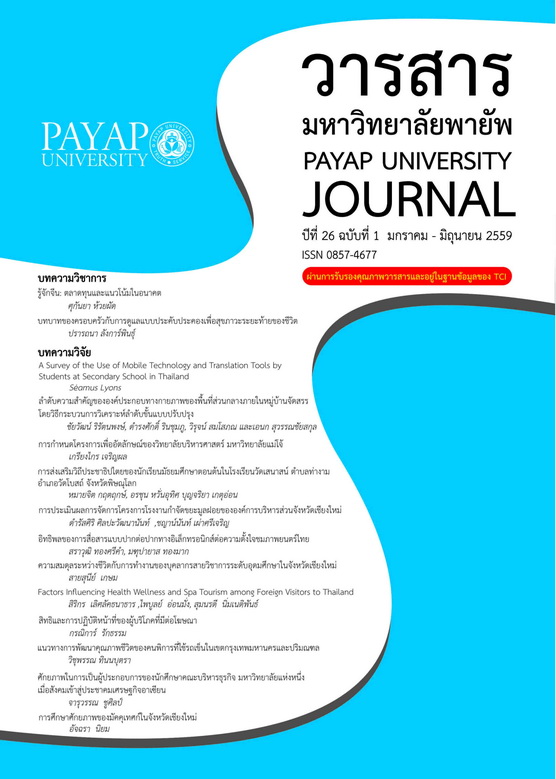อิทธิพลของการสื่อสารแบบปากต่อปากทางอิเล็กทรอนิกส์ต่อความตั้งใจชมภาพยนตร์ไทย
Main Article Content
บทคัดย่อ
อุตสาหกรรมภาพยนตร์ไทยถูกจัดให้อยู่ในหมวดอุตสาหกรรมสร้างสรรค์ที่ได้รับการสนับสนุนจากรัฐบาล เนื่องด้วยเป็นอุตสาหกรรมที่มีมูลค่าทางเศรษฐกิจสูง และช่วยเผยแพร่วัฒนธรรมของประเทศได้อย่างทรงพลัง อย่างไรก็ดีเป็นที่ยอมรับกันว่า ธุรกิจภาพยนตร์นั้นมีความเสี่ยงสูงทางด้านรายได้ ผู้สร้างภาพยนตร์หลายรายต้องประสบกับสภาวะขาดทุน การบอกต่อหรือสื่อสารแบบปากต่อปากทางอิเล็กทรอนิกส์ จึงเป็น กลยุทธ์หนึ่งที่สำคัญและมีต้นทุนต่ำ ในการจูงใจให้คนชมภาพยนตร์มากขึ้น วัตถุประสงค์ของงานวิจัยนี้เพื่อศึกษาปัจจัยต่างๆ ของการสื่อสารแบบปากต่อปากทางอิเล็กทรอนิกส์ที่ส่งผลต่อความตั้งใจชมภาพยนตร์ไทยซึ่งส่งผลต่อการตัดสินใจชมต่อมา ด้วยการนำทฤษฎีการกระทำด้วยเหตุผล (Theory of Reasoned Action: TRA) และแนวคิดของการสื่อสารแบบปากต่อปากมาใช้ โดยศึกษาในมิติของผู้ส่งสาร สาร และผู้รับสาร ประกอบด้วย 4 ปัจจัยหลัก ได้แก่ การรับรู้ความน่าเชื่อถือของผู้ส่งสาร การรับรู้การแสดงความคิดเห็นในเชิงบวก การรับรู้คุณภาพของภาพยนตร์ และการรับรู้ความเข้ากันได้กับผู้รับสาร ผลการวิจัยชี้ว่า การรับรู้ถึงความเข้ากันได้กับผู้รับสาร การรับรู้คุณภาพของภาพยนตร์ การรับรู้การแสดงความคิดเห็นในเชิงบวก และการรับรู้ความน่าเชื่อถือของผู้ส่งสารเป็นปัจจัยที่ส่งผลต่อความตั้งใจชมภาพยนตร์ไทยมากไปน้อยอย่างมีนัยสำคัญตามลำดับ และความสัมพันธ์ของความตั้งใจที่จะชมภาพยนตร์ไทยนั้นมีความสัมพันธ์กับการชมและไม่ได้ชมภาพยนตร์ตามความตั้งใจ ผู้ประกอบการในอุตสาหกรรมภาพยนตร์ไทยสามารถนำผลจากงานวิจัยนี้ไปใช้สนับสนุนการวางแผนทางการตลาดเพื่อเพิ่มโอกาสที่จะทำให้ภาพยนตร์ไทยประสบความสำเร็จได้
Article Details
เอกสารอ้างอิง
รักศานต์ วิวัฒน์สินอุดม. (2549). ทิศทางการพัฒนาอุตสาหกรรมภาพยนตร์ไทย. รายงานผลงานวิจัย คณะนิเทศศาสตร์ จุฬาลงกรณ์มหาวิทยาลัย, กรุงเทพฯ.
สำนักงานคณะกรรมการกำกับหลักทรัพย์และตลาดหลักทรัพย์ (2557). ตลาดทุน แหล่งเงินทุนของอุตสาหกรรมภาพยนตร์ มีนาคม 2557. สืบค้นเมื่อวันที่ 14 สิงหาคม 2557, จาก www.sec.or.th/TH/MarketDevelopment/Documents/Film%20industry-on-web.pdf
อัจฉรา ทองศรี.(2549). การศึกษารูปแบบ เนื้อหาและการใช้ประโยชน์จากการสื่อสารแบบบอกต่อ (Word-of-mouth Communication) เกี่ยวกับภาพยนตร์ในห้องเฉลิมไทย ของ www.pantip.com. รายงานโครงการเฉพาะบุคคล วารสารศาสตรมหาบัณฑิต สาขาวิชาการบริหารสื่อสารมวลชน คณะวารสารศาสตร์ มหาวิทยาลัยธรรมศาสตร์, กรุงเทพฯ.
แน่งน้อย บุญยเนตร. (2549). การสื่อสารการตลาดเพื่อการชมภาพยนตร์ไทย. นิเทศศาสตรปริทัศน์, 10(1), 95-110.
Ajzen, I., & Fishbein, M. (1980). Understanding attitudes and predicting social. Behaviour. Englewood Cliffs, NJ: Prentice-Hall.
De Bruyn, A., & Lilien, G. L. (2008). A multi-stage model of word-of-mouth influence through viral marketing. International Journal of Research in Marketing, 25(3), 151-163.
East, R., Hammond, K. and Lomax, W. (2008). Measuring the impact of positive and negative word of mouth on brand purchase probability. Intern. J. of Research in Marketing., 25, 215–224
Fishbein, M., & Ajzen, I. (1975). Belief, attitude, intention and behavior: An introduction to theory and research.
Ginsburgh, V., & Weyers, S. (1999). On the perceived quality of movies.Journal of Cultural Economics, 23(4), 269-283.
Hawkins, D. I., & Roger, J. Best, and Kenneth A. Coney (1998). Consumer Behavior, Building Marketing Strategy.
Hennig-Thurau T. , Gwinner K. P. , Walsh G. , and Gremier D. D. (2004). Electronic word-of-mouth via consumer-opinion platforms: What motivates consumers to articulate themselves on the internet?. Journal of Interactive Marketing, 18(1), 38-52.
Hennig-Thurau, T., Houston, M. B., & Walsh, G. (2007). Determinants of motion picture box office and profitability: an interrelationship approach. Review of Managerial Science, 1(1), 65-92.
Kim S.H. , Park N. and Park S.H. (2013). Exploring the Effects of Online Word of Mouth and Expert Reviews on Theatrical Movies' Box Office Success. Journal of Media Economics, 26 ,98–114.
Lee, K. T., & Koo, D. M. (2012). Effects of attribute and valence of e-WOM on message adoption: Moderating roles of subjective knowledge and regulatory focus. Computers in Human Behavior, 28(5), 1974-1984.
Lee E.J. and Shin S.Y. (2013). When do consumers buy online product reviews? Effects of review quality, product type, and reviewer’s photo. Computers in Human Behavior., 31 ,356–366.
Lu, L.C. , Chang, W.P. and Chang, H.H. (2014). Consumer attitudes toward blogger’s sponsored recommendations and purchase intention: The effect of sponsorship type, product type, and brand awareness. Computers in Human Behavior., 34 ,258–266.
Richins, M. L., & Root-Shaffer, T. (1988). The role of evolvement and opinion leadership in consumer word-of-mouth: An implicit model made explicit.Advances in consumer research, 15(1), 32-36.
Rogers, E. M. (1995). Diffusion of innovation. New York: Free Press.
Shin, D. (2006). Movie Preference Before Watching: The Role of Perceived-fit Between Movies and Actors (Doctoral dissertation, University of Georgia).
Triandis, H.C. (1979). Values, Attitudes and Interpersonnel Behavior. In Nebraska Symposium on motivation, Beliefs, Attitudes, and Values.University of Nebraska Press, 66. Lincoln, N E, 195-259.
Yeap, J.A.L. , Ignatius, J. and Ramayah, T. (2013). Determining consumers’ most preferred eWOM platform for movie reviews: A fuzzy analytic hierarchy process approach. Computers in Human Behavior., 31 ,250–258.
Zarrad, H., & Debabi, M. (2012). Online Purchasing Intention: Factors and Effects. International Business and Management, 4(1), 37-47.
Zhuang, W., Babin, B., Xiao, Q., & Paun, M. (2014). The influence of movie's quality on its performance: evidence based on Oscar Awards. Managing Service Quality, 24(2), 122-138.


